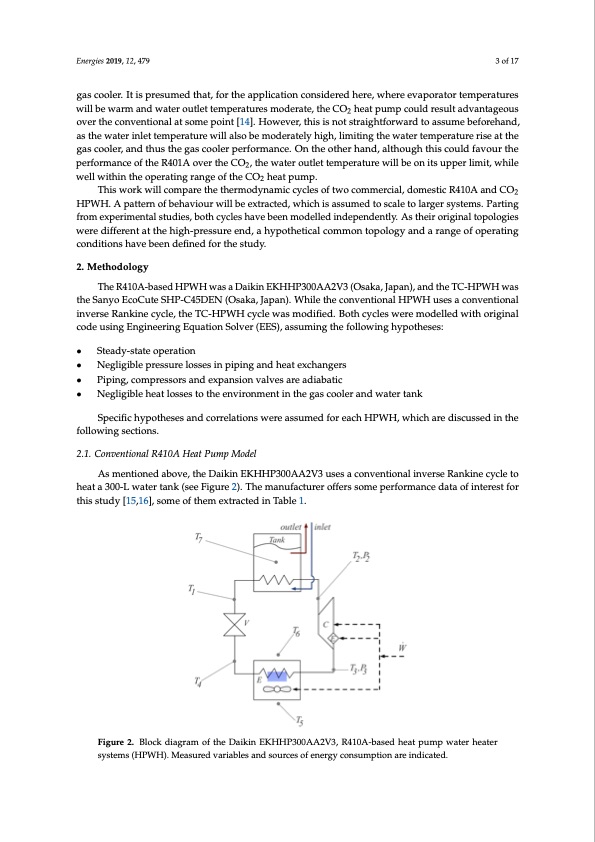
PDF Publication Title:
Text from PDF Page: 003
Energies 2019, 12, 479 3 of 17 gas cooler. It is presumed that, for the application considered here, where evaporator temperatures will be warm and water outlet temperatures moderate, the CO2 heat pump could result advantageous over the conventional at some point [14]. However, this is not straightforward to assume beforehand, as the water inlet temperature will also be moderately high, limiting the water temperature rise at the gas cooler, and thus the gas cooler performance. On the other hand, although this could favour the performance of the R401A over the CO2, the water outlet temperature will be on its upper limit, while well within the operating range of the CO2 heat pump. This work will compare the thermodynamic cycles of two commercial, domestic R410A and CO2 HPWH. A pattern of behaviour will be extracted, which is assumed to scale to larger systems. Parting from experimental studies, both cycles have been modelled independently. As their original topologies were different at the high-pressure end, a hypothetical common topology and a range of operating conditions have been defined for the study. 2. Methodology The R410A-based HPWH was a Daikin EKHHP300AA2V3 (Osaka, Japan), and the TC-HPWH was the Sanyo EcoCute SHP-C45DEN (Osaka, Japan). While the conventional HPWH uses a conventional inverse Rankine cycle, the TC-HPWH cycle was modified. Both cycles were modelled with original code using Engineering Equation Solver (EES), assuming the following hypotheses: • Steady-state operation • Negligible pressure losses in piping and heat exchangers • Piping, compressors and expansion valves are adiabatic • Negligible heat losses to the environment in the gas cooler and water tank Specific hypotheses and correlations were assumed for each HPWH, which are discussed in the following sections. 2.1. Conventional R410A Heat Pump Model As mentioned above, the Daikin EKHHP300AA2V3 uses a conventional inverse Rankine cycle to heat a 300-L water tank (see Figure 2). The manufacturer offers some performance data of interest for this study [15,16], some of them extracted in Table 1. Figure 2. Block diagram of the Daikin EKHHP300AA2V3, R410A-based heat pump water heater systems (HPWH). Measured variables and sources of energy consumption are indicated.PDF Image | Comparison of Transcritical CO2 and Conventional Refrigerant Heat Pump

PDF Search Title:
Comparison of Transcritical CO2 and Conventional Refrigerant Heat PumpOriginal File Name Searched:
energies-12-00479.pdfDIY PDF Search: Google It | Yahoo | Bing
CO2 Organic Rankine Cycle Experimenter Platform The supercritical CO2 phase change system is both a heat pump and organic rankine cycle which can be used for those purposes and as a supercritical extractor for advanced subcritical and supercritical extraction technology. Uses include producing nanoparticles, precious metal CO2 extraction, lithium battery recycling, and other applications... More Info
Heat Pumps CO2 ORC Heat Pump System Platform More Info
| CONTACT TEL: 608-238-6001 Email: greg@infinityturbine.com | RSS | AMP |